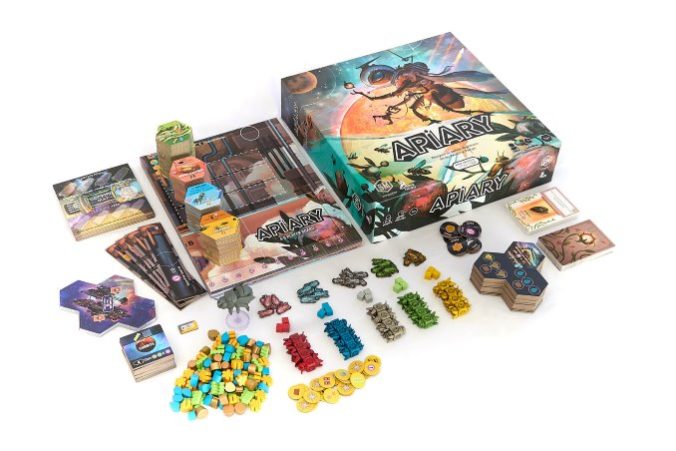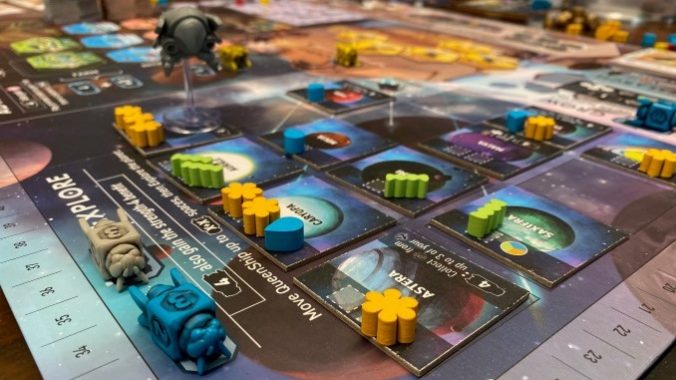Apiary made my top ten board games of 2023 list, offering an innovative take on worker-placement with the kind of high-quality art and components we’ve come to expect from publisher Stonemaier Games (Wingspan, Tapestry). Set in a distant future where bees have evolved to become the dominant species on earth and planets beyond, it offers a ton of decision-making with quick turns, the sort of game I love to recommend—and I do, but with some reservations.
In Apiary, each player is trying to build up their own hive of workers, taking any of six actions by placing their bees on the board to gain resources, place tiles on their hive boards, or add new worker bees to their supply. Each bee has four numbered sides, 1 through 4, representing its strength, with stronger bees able to do more with their actions. Bees with strength 4 often get bonuses when they’re deployed, and they’re the only bees that can take the Carve action to get the most valuable tiles.
There’s a catch: In Apiary, as in life, bees need to hibernate. You can’t redeploy a bee on the board unless it’s ‘bumped’ by another player’s bee looking to take its space, or you use the Retrieve action to bring the bees back home. When you do so, you increase the bee’s strength by 1 before returning it to your active pool for future deployments. Bees with strength 4 can’t get any stronger, and don’t you think they deserve a little rest, anyway? They must hibernate, which removes them from your supply for now. You’ll place one of your hibernation tokens in the row at the bottom of the board, gaining some great reward for losing the worker, and you can’t regain its use until you take the Grow action (with another bee) to get it back in your supply. This mechanism also determines when the game ends: Once the comb is full, or any player has used all seven of their hibernation tokens, everyone takes one last turn and the game ends.

You’re chasing multiple goals at once in Apiary, offering different paths to victory, although I don’t think you can ignore any of them entirely. You start with a hive board that’s mostly empty, so you can buy tiles of four different types (including those in the Carve action I mentioned above) that give you income, resource storage, one-time bonuses, or recurring powers. Covering your entire starting board is worth 8 points, and you can expand the board with four-tile pieces that get you 8 more points if you fill those too. Carve tiles can award you substantial victory point bonuses, while some other tiles give you 1-2 points in addition to their powers. There’s a deck of ‘research’ cards that give you single-use powers or that you can later ‘plant’ to get end-game points, although planting cards is, in my opinion, needlessly difficult to do as a regular action. Placing the most hibernation tokens in any one section of the comb gives you an area-control bonus. There’s also a track called the Queen’s Favor that gives you points for advancing along it. It’s a little point salad-y, but other than the research cards there’s enough synergy across the actions and points that the rest come together naturally.
The bump/strengthen mechanism also gives the game more interaction than the typical worker-placement game, many of which—even some I like—are essentially multiplayer solitaire, or maybe where the worst that happens is someone occupies an action space you want so you can’t use it. In Apiary, no space is ever blocked by another player’s bee, but bumping them also makes them stronger. If you want to use a space where someone has a strength 3 bee, you’d be giving them the upgrade to strength 4, which means the next time they use that bee, they get to do the most powerful actions on the board. You’re giving them a small but nonzero benefit, so maybe you’d rather hold off a turn or two before doing so.
Apiary promises a play time of 60-90 minutes, with up to five players able to play (the board has two sides, one for two to three players and solo, the other for four to five players with more spaces available), and I think that’s fair once everyone knows the game. Turns are very quick—you either move one bee from your little board to the main one, or you retrieve them all, and none of the actions takes that long to resolve, even ones with multiple parts. For example, certain Development tiles, one of the three types you can get from the Advance action (as in, advance your apian civilization), give you an immediate bonus action to resolve, so those turns might take twice as long. They’re still very quick, and the game-end condition is easy to get to once everyone starts their engines buzzing. (Sorry.)
I’ve played this more since first listing it on the top ten games of the year, and I’ve found that while I understand the game more and can play it better, I didn’t feel the compulsion to play again that I get with the best games. I think the main mechanic of bump-and-hibernate is clever and most of the game is well-designed (as is the Automa for solo play once you get the hang of it), other than that Research card bit, which feels like someone added an art deco room to a Victorian home. It also looks great—the worker bees are very impressively detailed, although the giant queen bee token you use on the Explore area is like the curly parsley on your dinner plate, “just for looks.”. Apiary’s a real honey of a game—and it makes me excited to try designer Connie Vogelmann’s newest one, Wyrmspan, a dragon-themed reboot of Wingspan that is about to go on sale as I write this review—but I just couldn’t connect with it like I thought I would after the first play.
Keith Law is the author of The Inside Game and Smart Baseball and a senior baseball writer for The Athletic. You can find his personal blog the dish, covering games, literature, and more, at meadowparty.com/blog.

